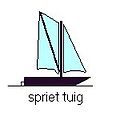

In modern usage, a sloop is a sailboat with a single mast [2] generally having only one headsail in front of the mast and one mainsail abaft (behind) the mast. It is a type of fore-and-aft rig. The mainsail may be of any type, most often Bermuda rig, but also others, such as gaff or gunter.
Contents
In naval terminology, "sloop-of-war" refers to the purpose of the craft, rather than to the specific size or sail-plan, and thus a sloop should not be confused with a sloop-of-war. As with many rig definitions, it was some time before the term sloop referred to the type of rig.
Regionally, the definition also takes into account the position of the mast. A forward mast placement and a fixed (as opposed to running ) bowsprit, but with two headsails may give categorisation as a sloop. An example is the Friendship Sloop. [1] : 48-53





